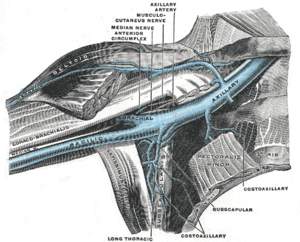"Underarm" redirects here. For the bowling style in cricket, see
Underarm bowling.
The axilla (also, underarm, oxter, or, colloquially, armpit) is the area on the human body directly under the joint where the arm connects to the shoulder. It also provides the under-arm sweat gland.
In humans, the formation of body odor happens mostly in the axillary region.[1] These odorant substances serve as pheromones which play a role related to mating. The underarm regions seem more important than the genital region for body odor which may be related to human bipedalism.[2]
Structure
Boundaries
Anatomically, the boundaries of the axilla are:
The lower posterior boundary is called the posterior axillary fold and this is a compound structure consisting of the latissimus dorsi and teres major muscles.[6]It can descend after weight loss.[7]
The anterior boundary is called the anterior axillary fold and this is rounded in shape and formed by the lower border of the pectoralis major.
Some sources also include the pectoralis minor.[8]It can elongate after weight loss.[7]
The contents of the axilla include the axillary vein and artery, as well as the brachial plexus, lymph nodes and fat.
The axilla is the space between the side of the thorax and the upper arm.
Contents
Society and culture
The term "underarm" typically refers to the outer surface of the axilla. However, the terms are sometimes used interchangeably in casual contexts. Colloquially, underarm refers to the hollow beneath the junction of the arm and shoulder.[9]
The term oxter is used in the Scots language instead of "axilla".[10]
Tickling
The underarm can be a ticklish area, possibly due to the number of nerves it contains. Some people find this area to be particularly unpleasant when tickled.
Underarm hair
Underarm hair usually grows in the underarms of both females and males, beginning in adolescence.
In some modern Western cultures, it is common for women to remove underarm hair. Some view this practice as an aesthetic matter, while others view its removal as a possible effect of health related concerns. As underarm hair grows quickly, shaving must be performed frequently, or else stubble will appear in the axilla.
Throughout the feminist movement, previously in the hippie culture, and in some areas of the punk rock scene, some women choose to keep their underarm hair for a variety of reasons, from subversion to egalitarianism to comfort. Conversely, some men choose to remove their underarm hair for similar aesthetic reasons or to reduce friction in some sports, such as swimming. In a wider context, similar human habits exist also in relation with other hairy areas of the body.
Clinical significance
Lymphogenic spread of breast cancer
Breast cancer typically spreads via lymphatic vessels to the lymph nodes found in the axilla.
Axillary intertrigo
Excessive perspiration can result in axillary intertrigo. Intertrigo is an inflamed skin condition caused by heat, friction, and moisture.[11] A warm, wet underarm may accommodate the growth of pathogenic bacteria, yeasts, and fungi.[12] The condition is responsible for rash-like symptoms, pustules, or chronic itching or burning in the underarm.[11] Axillary intertrigo is common among those who work in hot environments.[12]
Additional images
| Anatomy of the axilla |
|---|
| Superficial muscles of the chest and front of the arm. |
| Axillary artery and its branches - anterior view of right upper limb and thorax. |
| The veins of the right axilla, viewed from in front. |
| The right brachial plexus (infraclavicular portion) in the axillary fossa; viewed from below and in front. |
| The left side of the thorax. |
|
See also
 |
Wikimedia Commons has media related to Armpits. |
Notes
- ↑ Turkington, Carol; Dover, Jeffrey S. (2007). The encyclopedia of skin and skin disorders (3rd ed.). New York: Facts on File. p. 363. ISBN 978-0-8160-6403-8.
- ↑ The Oxford Handbook of Evolutionary Psychology, Edited by Robin Dunbar and Louise Barret, Oxford University Press, 2007, Chapter 22 Body odours and body odour preferences in humans by Claus Wedekind
- 1 2 "Anaesthesia UK :AnaesthesiaUK: Applied anatomy for upper limb blocks". Archived from the original on 2008-10-16. Retrieved 2007-12-23.
- 1 2 3 4 "LAB #4 PECTORAL REGION & Introduction to the Axilla". Retrieved 2007-12-23.
- 1 2 "Dissector Answers - Axilla and Arm". Archived from the original on 2007-12-10. Retrieved 2007-12-23.
- ↑ lesson3axilla at The Anatomy Lesson by Wesley Norman (Georgetown University)
- 1 2 Hurwitz, D.; Neavin, T. (2007). "Body Contouring of the Arms and Brachioplasty". Handchirurgie · Mikrochirurgie · Plastische Chirurgie. 39 (3): 168–72. doi:10.1055/s-2007-965236. PMID 17602378.
- ↑ lesson3axilla at The Anatomy Lesson by Wesley Norman (Georgetown University)
- ↑ "Definition of armpit - Merriam-Webster Online Dictionary". Archived from the original on 15 December 2007. Retrieved 2007-12-23.
- ↑ "BBC - Voices - Multilingual Nation". Archived from the original on 26 December 2007. Retrieved 2007-12-23.
- 1 2 Selden, Samuel, MD. Intertrigo. emedicine, WebMD. March 9, 2007. Accessed May 21, 2009.
- 1 2 Occupational Dermatoses - A Program for Physicians. National Institute for Occupational Safety and Health. April 17, 2001. Accessed May 21, 2009.
External links
|
|---|
|
| Head | |
|---|
|
| Neck | |
|---|
|
| Trunk | |
|---|
|
| Limbs | |
|---|
|
| Other | |
|---|
|
General anatomy: systems and organs, regional anatomy, planes and lines, superficial axial anatomy, superficial anatomy of limbs |






